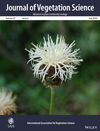New article: Updating vegetation classifications.
 How can existing vegetation classifications be updated when new plot data are obtained? Can we use the properties of plots classed as outliers to identify gaps in our understanding of vegetation patterns and so direct future enquiry?
How can existing vegetation classifications be updated when new plot data are obtained? Can we use the properties of plots classed as outliers to identify gaps in our understanding of vegetation patterns and so direct future enquiry?
In a paper recently published in Journal of Vegetation Science, Susan K. Wiser (Landcare Research, New Zealand) and Miquel De Cáceres (CTFC) updated a pre-existing classification of New Zealand’s forests and shrublands, based on a nationally representative data set (1177 plots), by using 12,374 additional plot records from New Zealand’s National Vegetation Survey Databank.
To update the classification, they first cast the original classification into the fuzzy classification framework of Noise Clustering and then discarded original types with low plot numbers and high compositional variation. They then used the plot records that could not be assigned to any original alliance to define new types, while retaining the original ones as fixed elements.
Their analysis illustrates the application of a fuzzy classification framework at a national scale and provides a model for others wishing to extend and update vegetation classifications. This approach allows rare community types to be defined and identifies portions of compositional and geographic gradients that are poorly documented.
—————————————-
Actualitzant classificacions de vegetació.
Com podem actualitzar una classificació existent de la vegetació mitjançant dades noves? Podem utilitzar les propietats dels inventaris classificats com a outliers per a identificar mancances en el nostre coneixement dels patrons de vegetació, i així dirigir noves prospeccions?
En un article recentment publicat a Journal of Vegetation Science, Susan K. Wiser (Landcare Research, New Zealand) i Miquel De Cáceres (CTFC) han actualitzat una classificació inicial dels boscos de Nova Zelanda mitjançant 12374 inventaris addicionals, provinents del banc de dades nacional de Nova Zelanda.
Per tal d’actualitzar la classificació, varen reformular la classificació original dins d’un nou marc de treball de classificació, basat en la logica difusa i descartaren aquels tipus de vegetació amb pocs inventaris i molta variabilitat. Tot seguit, empraren els inventaris que no es podien assignar clarament a cap grup per tal de definir nous tipus de vegetació, retenint els originals com a elements fixos.
La seva análisi il·lustra la aplicació d’un mètode de classificació difusa a l’escala nacional, un model que pot ser utilitzat en altres paisos. Aquesta aproximació permet definir tipus de comunitats rars i identifica parts del gradient de composició d’espècies que estan insuficientment documentades.




